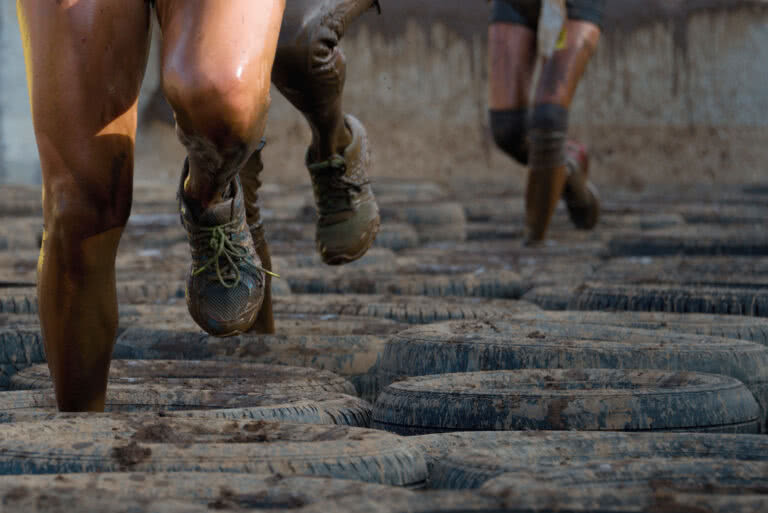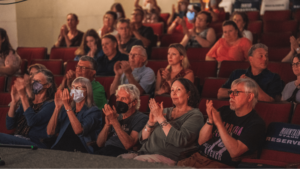In partnership with Mudstacle, we took a look into the world of obstacle course races to find out who registers for races, why people sign-up for them, and what attracts them to certain races in the first place.
Download the full report ‘All the Mud & Race Statistics You Need To Know’
As you can see from the below extract of the Mudstacle Report, there are a number of influencing factors that help potential participants decide whether to enter a race or not.

To look further into these influencing factors we asked a number of OCR organisers from all over the UK for their top tips for creating the perfect obstacle race.
Here are their top tips.
Mark Leinster, CEO at Obstacle Course Racing Association UK (OCRAUK)
1. Permanent or portable
Is your course going to be permanent or will it all be packed up and moved to differing venues throughout the year?
Advantages- you can add to your course or obstacles whenever you want without trying to fit everything into a pre-determined timescale for the build. This also helps as you can procure materials as budget dictates. You can also make things bigger because you can place permanent supports and foundations.
Disadvantages- Your course can become too familiar as people get to know the course and terrain, and the same big obstacle is always in the same place. The structures are also open to the elements and need constant care and attention as we have already seen with some older permanent races, structures are starting to show their age.
2. Ground & terrain
Let the lay of the land dictate what obstacle you place where. It’s all very well having the best rope climb in the world but if it is after your best and muddiest part of the course it becomes unachievable.
Also be mindful that just because there is something there, doesn’t mean you have to use it; just because there are fields of nettles on your course doesn’t mean it will be fun for the competitors to go through it. I’ve still yet to see a comment after a race saying “Oh and weren’t the nettles great.”
Consider every obstacle location as if an incident happened at that location, can the medics get there? Is there radio or phone signal? There’s no point in placing your best and most challenging obstacle in a communications black spot. Check communications as part of your ground recce.
3. Build safe
Just because you have done a few OCRs does not make you an OCR builder or advisor.
Get some advice from people who do it for a living and have at least a relevant qualification behind them, for example health & safety, construction tradesman, event management etc.
The sport of OCR will always be challenging and as it progresses will demand more innovation and challenges to whet our appetite for fear, so if you want to build a 100ft mega obstacle, thats fine!…but let’s build it safely and ensure it’s not built to intentionally harm the participants.
There are a number of people in the industry now who are very proficient at building and designing OCRs and OCRA UK are always at hand to give you independent advice.
4. Plan it
Some of the best courses I have seen have started with a conversation in a pub and some quick sketches. I never go anywhere without my “book of plenty” which has every idea for an obstacle or course design, but getting it from paper to reality is a huge undertaking.
Start by setting a date and work backwards going through everything from procurement of materials to labour, to venue hire, even thinking about how you will feed and water your volunteers on the day.
However well you plan your build, be flexible; things can and will change i.e. budget, labour, weather etc. but above all else – if you do nothing else – check your course on the morning of race day. Whether you or a trusted team do it, tackle it in sections and report back. A good bit of advice is “If it hasn’t been checked, it hasn’t been done”.
5. Keep it fun!
Remember that although you may be trying to “keep up with the Jones'” and build the biggest and best, you must also remember that it is the ordinary, decent, fun-loving people that pay for the sport. The holy grail of any obstacle build is the balance between fun and achievability for the participant or teams that take part for fun, and those that take part to be constantly challenged and pushed. Keep them both happy and you will have a happy race.
Let’s not forget the spectators; they add so much to the atmosphere of a race, I’ve seen so many events where after the last wave went the event village became a ghost town. A good MC will always help by giving out information on where and when participants can be seen, so consider having part of the route swing in and out of the event village. The OCR Championship later this year has already incorporated this into the course design.
Lloyd Peacock, Race Director at Warrior Run Ltd
- Listen to the people! We have built each event based on feedback from previous events. Although don’t get bullied into doing things you don’t believe in.
- Stick to the original game plan. Why did you start this event in the first place? It worked then so it will work now, just make sure you’re in it for the same reasons.
- Do not copy other races. I know that you must have some of the signature obstacles at your event to keep the crowds happy but be original; Ii we were all the same the world would be a very boring place.
- Look after your marshals, you wouldn’t have an event without them.
- Run every course yourself, if you don’t enjoy it then you’ve done something wrong!
Drew Tavernier, Founder – Creative / User Experience Director & Event Organiser at Ultimate Adventures
1. Challenge people – with every course line we lay, and every obstacle we put together, it’s about how to challenge someone to push them beyond what they thought they could do and make them realise what they can do.
2. Use your terrain – make the most of what the earth gives you, if there’s a hill; run up it, if there’s a stream; run through it.
3. Customer service is key – be good to your runners, and they will love you for it.
4. Passionate volunteers make your race – they represent the heart and soul of what you are trying to achieve so treat them like kings.
5. Love what you do and your runners will love it too.
Michaela Brice, Event Manager at The Royal British Legion Major Series
Our races cater for both the “compete” and “complete” audiences; satisfying not just those running to win and secure a league place but also those completely new to OCR looking for a fun run. We do this by offering safe and achievable obstacles but with a mix of terrain that’s sure to test even the most experienced racer. We actively seek out the best bogs and ‘stench trenches’ and this is where you’ll often find the most laughter coming from!
We review each race individually, listening to our audience to tailor our events for their needs. For example, we know that our participants rate high-quality obstacles so have recently invested in 3 brand new ‘hero obstacles’ in response to this feedback. We also offer all participants a medal and a t-shirt because for 63% of our entrants it’s their first time running the Major Series and often even their first race, so this is valued very highly compared to other races.
With tiered pricing options, we offer ticket prices as low as £40. Interestingly, the level of take-up for our early bird discount varies significantly across the country, with different purchase behaviour for each event.
We have probably the most (volunteer) instructor-heavy course in the UK. This helps us rank very highly across both safety and support, which are two areas we really pride ourselves on, particularly with so many first-time racers taking part. Having support and encouragement along the course is part of the atmosphere and camaraderie that keeps people returning for consecutive events.
Our newly designed event offers zoned areas along the course, with special effects in each – from smoke and fire to gunfire sound effects and music. We’ve been praised for offering something a bit out of the ordinary with these added features, and we’re looking to develop this further as the races progress in the future.
Michael Smith, Director at Boom Events
1. Speak to event organisers in different geographical areas. They are more likely to share experience and advice with you, if you are not in direct competition.
2. Selecting a good date is vital. Consider holidays, weather, local events and major events which may affect your sales.
3. Do a feasibility study before setting pricing and launching an event. You need to consider permits, insurance, build, marketing, medical cover, race packs and any other costs associated with the event, before setting ticket costs.
4. Event logistics are vital; parking, traffic management, route planning, build logistics and village facilities are key to a successful event.
5. Identify your target market. It is important you know what type of person is attracted to your event, so you can promote your event to them and maximise your promotional spend.
Conclusion
There are a lot of take aways from the above tips, with many of the OCR organisers highlighting some of the same points. Collectively they all agree that originality, health & safety, and a varied course to satisfy the needs for both the ‘compete’ and ‘complete’ audience are key elements for creating the perfect obstacle race.





